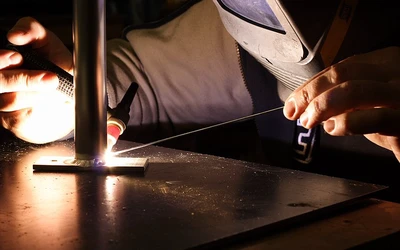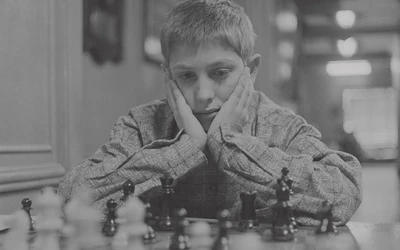
Bronstein Chess
Exploring the gems on Pychess - Mini Series about Variants Part 1Intro
In this series of mini articles, I'd like to talk about some variants I’ve discovered on PyChess and have been captivated by. Each of these shorts will typically cover these three questions about the certain variant.
- How to play?
- Why do i love it?
- Tips
Bronstein Chess
How to play it
First variant I'd like to introduce in this article series is a chess variant that has been credited to WC Challenger David Bronstein and called with various names such as Placement Chess, Pre-Chess, Shuffle-Chess. As might as the names and discussion about the origin of its invention might vary, the idea behind this variant is very simple yet powerful: players determine their back-row pieces themselves by dropping them in a turn-based behaviour. This free-spirited approach opens a door for lots of new creative ideas while preserving basic rules of chess: Pieces move as usual and game ends with checkmate. Think of it as a kind of manual Fischer Random Chess / Chess960 except the cards are not shuffled and dealt for you but you get to choose how you place them. Castling is only possible when you place your king and your rook in their usual starting position though. Bishops need to be placed on opposite color squares. Everything else stays the same. ( See full rules here And if you believe some positions in Chess960 are too random or favor one side unfairly, in Bronstein Chess, you wouldn’t have any excuses :)

Silence before the storm!
Why do I love it?
The ability to decide the starting positions of your own pieces, as well as the ability to strategically react on your opponents placement decisions, takes tactics and strategy to a whole new level. In comparison to Chess960, where the opponents pieces mirror yours, placement is free from such symmetrical obligations. Therefore, it is pretty common that you might start with kings on opposite sides of the board. Such games turn into a sharp Sicilian-like fight and a race for checkmate starts right from the first move (or ninth, if we count the drops), which is exciting and very fun for all those who love wild games full of tactics. But it is also very interesting and fun to experiment with standard setup vs manual setup, where one side places their pieces just like in their usual positions while other side places them differently, trying to take advantage of the standard starting position.
I should say that the game reminds me a bit of strategy games like Age of Empires. You place your pieces, you build a solid base to begin with and when you are ready, you can go onto offensive mode and make the first move to launch an attack. This pre-contact building up phase requires some strategic considerations, which I enjoy a lot like in those computer games. That phase is also a kind of puzzle-like challenge, where you are trying to solve a problem or riddle. In this case, the riddle is piece harmony and coordination as well as their mobility. So some games can be therefore ‘won’ without ‘making a move’, almost like ‘winning without fighting’. With other words, the starting positions after all the pieces are dropped might turn out to be highly advantageous for one side. This brings me to the last topic of the article: Tips for strategies.
Tips
-- Placing pieces are committal decisions. Where you place your king is essential in determining the nature and structure of the game. By placing your king in a certain square, you give away information to your opponent, where your king will start to game and your opponent try to use this knowledge to his/her advantage by e.g. placing rooks and queen in the same file to the king to launch an early and quick attack. This means it is better to start with placing minor pieces and postpone the dropping of heavy ones or the king as much as possible.
-- The order in which you place your pieces matters! Try to pay close attention to the order you and your opponent chooses to place pieces. You can make bluffs or trick your opponent to place a higher value piece before you do so that you can take advantage of that by reacting accordingly.
-- Think holistically, instead of individually. Try to come up with a setup that makes sense as a whole and allows pieces to develop with the least amount of interference in each other's development. This notion of integrity and coordination of pieces is a common topic in piece development in Chess960. So if you have a certain familiarity with Chess960, it might definitely prove to be handy, as you’ll have an intuition built already about some possible ideal piece combinations. You can get inspired by certain Chess960 starting positions, with which you’ve felt comfortable.
-- Having rooks in the middle or if possible, opposed to the opponent's king is ideal. Try to keep your king as safe as possible. One setup that the engine particularly likes is like minors around the king: BKNN (like Ba1, Kb1, Nc1, Nd1) etc.
-- Beware of the undefended pawns both in your setup and your opponents.
Here is a fun game, where white has tried to hide my intention of going with the standard setup:
Another sharp game with some fireworks to just a give a taste of this variant:
Bottom line is just experiment with different stuff and see what works and not. This way, you will not only have fun, but can gain a deeper understanding of some aspects of chess, such as mobility, space advantage, coordination etc in a way that is usually taken for granted in standard chess.
Enjoy the game and feel free to share your experiences about it!
Stay tuned for more!
You may also like
 NM visualdennis
NM visualdennisCurated Lichess Studies
Collection of high quality or original studies on Lichess thibault
thibaultHow I started building Lichess
I get this question sometimes. How did you decide to make a chess server? The truth is, I didn't. NM visualdennis
NM visualdennisHow does the knight move?
Visual guide to the power of knights ️ CouchTomato87
CouchTomato87Celebrating the Mid-Autumn Moon Festival with Chess
An introduction to some things Chinese - culture, food, and of course, chess. NM visualdennis
NM visualdennisQueen’s Gambit (TV Series) and why we love chess (Spoiler alert)
On the Queen's Gambit (TV Series) and why we love chess NM visualdennis
NM visualdennis